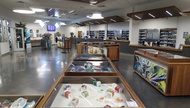It’s getting hotter. The nonprofit scientific research organization Climate Central reports that average summer temperatures in Las Vegas have risen nearly six degrees since 1970, and Southern Nevada remains one of the fastest-warming metropolitan areas across the west—getting hotter faster than Phoenix, Salt Lake City and El Paso.
Sweet Science: UNLV Research
Finding and promoting new ways to cool off—and ultimately, build a more sustainable and efficient desert city for the future—is the focus for UNLV professor of architecture and urbanism Steffen Lehmann, an internationally recognized researcher, educator and designer. Originally from Stuttgart, Germany, he has been in Las Vegas for almost six years, having previously worked in the U.K. and Australia. “My idea is always to go where you have real problems and challenges to solve,” he says, and Las Vegas has proven to be a fertile place for his expertise.
For the past 25 years, Lehmann has researched mitigation strategies for the built environment in relation to the urban heat island effect, to help these cities cope with global warming and climate change impacts. His recent studies and published papers run the gamut: contrasting Las Vegas with Adelaide, Australia, and optimizing urban cooling strategies surrounding the many parking lots in both cities; exploring the evolution of mass timber construction and how current innovations can be expanded to create a more energy-efficient home-building and general construction industry; and honing in on the research methods behind urban design in the hopes of building a stronger foundation of sustainability and “the resiliency of places.”
“What I try to do in my research is [go beyond] the design aspects and emphasize that the economic and health impacts are the drivers,” Lehmann says. “I always say to the team that we need to communicate a positive message, not a doomsday message, but what can be done—a message of hope, never alarmism. Our research is always based on signs, grounded in common sense, practical solutions, and we try to work with industry [sources] as much as possible.”
Las Vegas needs solutions specific to its unique climate and geography, he says, urban cooling innovations that go beyond air-conditioning our homes, schools, casinos and offices. “Solar really is the future and there’s more solar available than any other place, so we should do more with it. But we also need to think about surfaces that do not store heat and do more research on reflective coatings on new construction products. How do we do white pavement? How do we integrate vegetation and greenery to lower surface temperatures? What trees are giving us the biggest bang for the buck?”
As detailed in the mass timber paper, modular offsite manufacturing of houses—in which components of a new home are built assembly-line style at a factory, like cars or computers, then shipped to the site—is becoming successful in the Pacific Northwest and Canada and could be a meaningful innovation in Southern Nevada, one that could bring less expensive, more energy-efficient homes to the region while producing much less construction waste.
The vast suburban sprawl that makes Las Vegas such a fascinating young city also contributes to the urban heat island effect. Our reliance on cars steadily elevates air pollution in the Valley, while new construction continues to spread to the edge of our borders.
“More suburbs, more isolated people sitting in fully air-conditioned houses,” Lehmann says. “One thing we can learn is that urban infill is the future, because it’s much more economical to develop new housing in already built-up areas where the infrastructure already exists rather than greenfield development outside the city [core]. We need to stop creating sprawl, to say enough is enough—the footprint of the city doesn’t need to grow outward but to grow, compact, inwards.”
Lehmann and his collaborators are starting to work with Nevada lawmakers—and with officials and researchers across the west—to revamp construction codes in order to encourage builders and city planners to better incorporate such sustainable materials and combat heat and climate change. He cites a recent five-year National Science Foundation urban heat island study of six U.S. cities and five in Australia as a model for a similar project he’d like to conduct looking at desert cities in the southwest, and that process has started, though funding hasn’t been secured.
“We have grand challenges and architects alone cannot solve them,” he says. “We have to work together, scientists, experts, builders, everybody contributing something. A city is complex, and not one profession alone can fix it. It requires an interdisciplinary approach, just like research.” –Brock Radke
Click HERE to subscribe for free to the Weekly Fix, the digital edition of Las Vegas Weekly! Stay up to date with the latest on Las Vegas concerts, shows, restaurants, bars and more, sent directly to your inbox!





